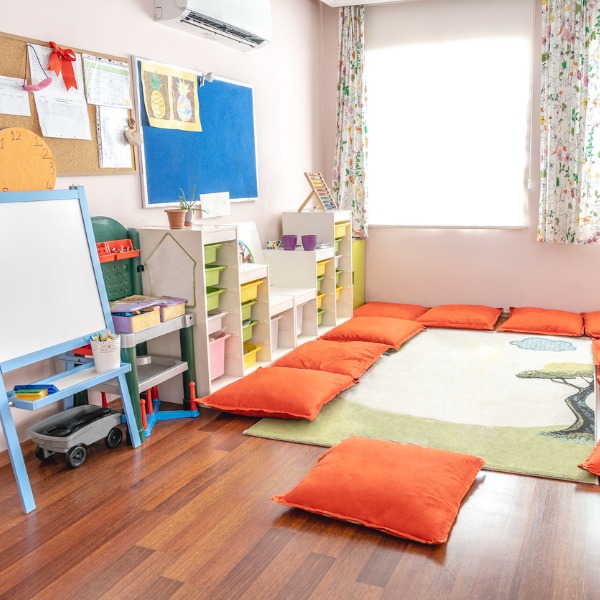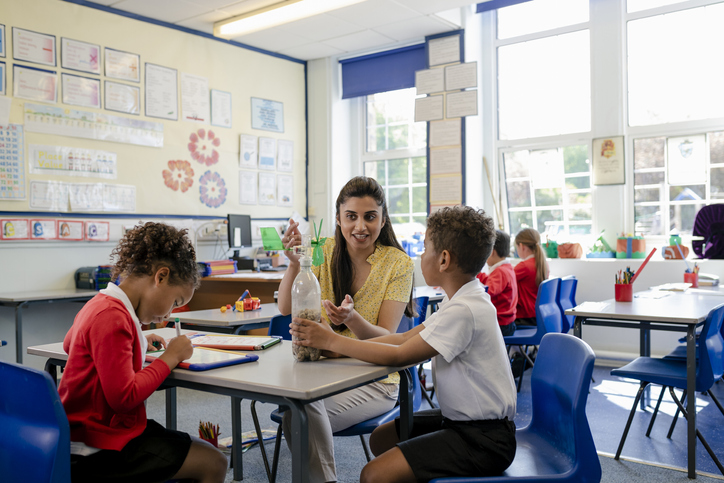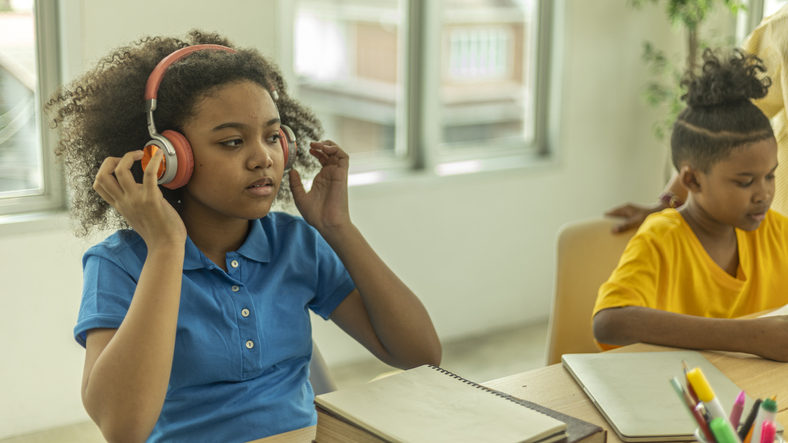Creating Positive Learning Environments

Comfortable learning space (Circle Creative Studio, iStockphoto)
Explore how to create positive learning environments that support learners’ social, emotional and cognitive development.
What is a learning Environment?
Just like a wetland or a woodland, a classroom is a type of habitat. It is filled with living creatures with unique needs that must be met. If those needs are met, the creatures thrive. But if they are not met, the opposite can happen. In a classroom, the teacher plays a central role in determining the health of the habitat.

Students talking to their teacher (Source: yacobchuk via iStockphoto).
Image - Text Version
Shown is a colour photograph of four students talking to their teacher. The teacher is seated at the end of a rectangular table with an open laptop and tablet on the table. The teacher has long black hair, olive skin and is wearing a pale blue, button down shirt. The teacher is surrounded by the students. On the table is a white wind turbine model, along with miniature tree models spread out at the base of the wind turbine. On the far left of the photo, a student gestures with arms out in front and elbows bent. Three other students listen intently. The wall behind them has colourful circles with white science themed icons inside them. There is a red bookcase on the far right of the photo.
A teacher needs to consider more than just if students’ basic needs for food, water and shelter are met. A teacher needs to consider how the learning environment meets the social, emotional and cognitive needs of students. Below are suggestions for structuring spaces to foster positive learning environments.
Elements of a Positive Social Environment
It is important that all students, no matter their race, gender, national origin, disability, religion, language, and class can see, hear and feel themselves represented in the classroom environment.
Seating Arrangements
For example, by changing seating arrangements in different ways, students can get to know other students that they may not normally engage with. And by giving students the chance to sometimes sit alone, in pairs and in small groups, they have the opportunity to engage with others with differing levels of social interactions.

Pair of students sitting together (Source: SolStock via iStockphoto).
Image - Text Version
Shown is a colour photograph of a teacher sitting between a pair of students at a small grey rectangular table in a classroom.
On the far left, a student sits with head bent and appears to write on a small white board. Most students are wearing a red top and dark bottom uniform. The teacher has brown skin, long brown hair and is wearing a yellow v-neck t-shirt. The teacher and the student on the right appear to be gesturing to a tall pop-bottle on the table. Behind them are two other tables, one table is occupied by two other students. The chairs are blue, along with the frame of the window behind them and bulletin board to the left. The classroom has one small and one large window, allowing lots of natural light into the room.
Ensuring that there is an equal opportunity to participate, such as space for wheelchairs and guide dogs, can help students feel socially included.
Contextual Cues
Objects and other contextual cues in the environment can also signal who belongs and can activate biases that make certain students feel unwelcome. For example, girls may feel less comfortable in a classroom where masculine images and objects dominate. As well, holiday displays for only a single dominant religious group can make students from other religious groups feel less included socially.

Holiday greetings can be displayed in many languages (Source: ricochet64 via iStockphoto).
Image - Text Version
Shown is a colour illustration of a word cloud displaying happy holidays in different languages. The text is in colourful bold block lettering and runs both across and up and down on the image.
| Social Environment Self-Assessment questions: |
|---|
|
Elements of a Positive Emotional Environment
Students, like teachers, do not leave their emotions at the door of the learning environment. A positive emotional learning environment gives students a sense of feeling safe and secure. This includes being a safe place to explore their feelings and develop ways to constructively express their feelings over a range of emotions, positive and negative. It also includes being a space where triggers for emotional insecurity are minimized.
Giving and Receiving Feedback
To foster ways for students to safely explore their feelings, teachers can provide opportunities for students to give and receive feedback, to be good listeners and to develop empathy. This could look like putting up a word wall with words to express feelings, or tips on how to be empathetic.
Safe Spaces
In the physical space, teachers can support students by providing places where students can safely go when they are experiencing difficult emotions. This may be a special chair, like an egg chair or bean bag chair, a couch or room off the classroom. It may also be an object that they can hold, like a fuzzy blanket or stuffed toy.
Teachers should also be aware of how students feel when placed in different locations around the room. For example, students at the front of the room may experience anxiety if they feel that other students are constantly looking at them. Students at the back of the room may feel less supported by the teacher.

Pair of students sitting together (Source: SolStock via iStockphoto).
Image - Text Version
Shown is a colour photograph of seven students with different hair and skin colours seated side-by-side. The students are wearing bright coloured tops and jeans. In the back of the room, there are black and green coloured bulletin boards with colourful items on display.
Finally, teachers should ensure that students feel physically safe and secure. This could mean having tools that are suitable for the hands of students, furniture that fits different body sizes and shapes, avoiding placing objects where they can become tripping hazards, etc.
| Social Environment Self-Assessment questions: |
|---|
|
Elements of a Positive Cognitive Environment
Students “differ in how they perceive and comprehend information, how they navigate a learning environment to express knowledge, and how they are engaged or motivated to learn.” No two people learn in exactly the same way, but most people tend to prefer certain ways of learning. For example, some students require visual support to learn, others benefit by talking and others may need auditory cues. Some benefit from learning with others and others require time to learn on their own. Some students learn best when it is quiet, while others learn best when there is noise. By acknowledging that students learn best in many different ways, a positive cognitive environment provides students with opportunities to learn in ways that support their learning. Knowing how their students prefer to learn can help teachers structure a positive cognitive environment; this is an ongoing process!
Customizable Learning Supports
For example, teachers can provide opportunities for visual learners by providing books, posters, videos, and pictorial instructions. They can provide auditory learners with audio books, videos with closed captioning, and spoken directions. They can provide kinesthetic learners with physical materials, opportunities to move around when thinking, and different places to work such as standing desks and whiteboards. They can provide social learners with group activities and projects and solitary learners with individual activities and projects. They can also provide students opportunities to share their learning orally, visually and kinesthetically as well as, or in addition to, text.
Sometimes a given way of learning may be helpful to one student but disruptive to another. This is why it is also helpful to have some additional tools and supports such as headphones to use when students are listening to a video or doing quiet work, or a secondary space such as the hallway to use when students are moving around to collaborate.

Student using headset (Source: Ronnakorn Triraganon via iStockphoto).
Image -Text Version
Shown is a colourful photograph of two students seated at a table in a classroom. Through the window behind them, out of focus buildings can be seen. Student on the left is in the midst of putting on a pair of red headphones. This student is wearing a blue top, has mid-length brown curly hair and brown skin. The student on the right is wearing a yellow top with curly brown hair tied up at the top of the head. There are various school supplies spread out on the table.
| Cognitive Environment Self-Assessment questions: |
|---|
|
Involving Students in Shaping the Learning Environment
Since creating a positive learning environment is about helping students thrive, then students should be at the heart of creating the learning environment.
For example, teachers could conduct a learning environment assessment with students. Students could be encouraged to consider the three main areas (social, emotional and cognitive) discussed here. If they are unsure of the types of questions to ask, prompts could be provided based on the self-assessment questions in the callout boxes above.

Students writing on whiteboard (Source: SolStock via iStockphoto).
Image - Text Version
Shown is a colour photograph of students working at a white board. On either side of a teacher are two students at the front of the room. Student on the left is showing the teacher something on a tablet and the student on the right, holds a dry-erase marker by the board while observing the tablet with a turned head. There is a student further back on the left side of the classroom. Students and teachers have different hair and skin colour. They are wearing similar coloured clothing of yellow and blue.
Students could even make a project out of designing a more inclusive and positive learning environment for all. Alternatively, teachers could anonymously survey students and implement suggestions that the class votes on.
Conclusion
Although teachers do not have control over every aspect of the learning environment, such as temperature, air quality and lighting, they do have control over many aspects of the learning environment that make it welcoming and safe. Even small changes to things like seating arrangements, learning materials and what goes up on the walls, can make a big difference to students' social, emotional and cognitive development. It is never too late in the year to make a small shift or try something new to make the “habitat” a better place for students.
Learn More
Classroom Environment Strategies
This article, from the Cornell University Centre for Teaching innovation has suggestions for ways to create a sense of belonging,
References
Croner-i. (2012). The emotional environment